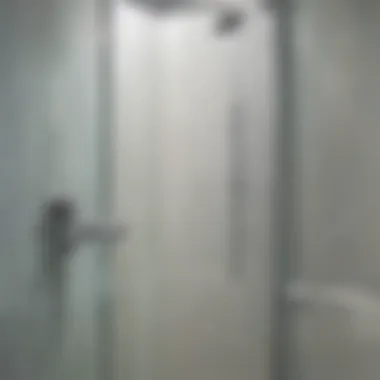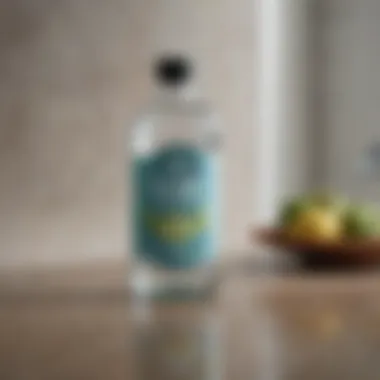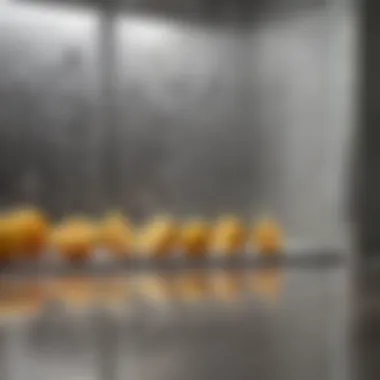Effective Methods for Removing Water Marks from Glass Shower Doors


Intro
Water marks on glass shower doors are a common nuisance. They create an unsightly appearance that detracts from the otherwise pristine look of your bathroom. Understanding the methods to effectively remove these marks can extend the lifespan of your shower doors and enhance the overall aesthetic of your space. This guide aims to explore various techniques, from natural remedies to specialized cleaners, providing you with a toolkit to combat these stubborn stains.
In this article, you will find detailed step-by-step instructions on how to treat water marks, understand the effectiveness of different cleaning solutions, and learn how to prevent these stains in the future. With a combination of household ingredients and expert advice, maintaining clear and spotless glass shower doors can be straightforward.
Understanding Water Marks
Water marks are typically caused by hard water, which contains high levels of minerals such as calcium and magnesium. When water evaporates, these minerals are left behind, resulting in unsightly white or cloudy stains. As moisture accumulates over time, these marks can become more entrenched. Hence, knowing how to address this issue is essential for every homeowner.
Effective Cleaning Methods
Natural Solutions
- Vinegar and Water: A solution made from equal parts of white vinegar and water can be an effective cleaning agent. Simply spray it on the glass, let it sit for a few minutes, and then wipe it away with a soft cloth.
- Baking Soda Paste: For tougher stains, a paste made from baking soda and water can work wonders. Apply it to the affected areas, scrub gently, and rinse thoroughly.
Store-Bought Cleaners
Using specialized glass cleaners can also be an effective route. Products like CLR Calcium, Lime & Rust Remover or Glass Plus can tackle the hardness of water stains with ease. Ensure to follow the manufacturer's instructions for best results.
Tools to Use
When removing water marks, the tools you use are just as important as the cleaning solutions. Here are some recommended tools:
- Microfiber Cloths: These do not scratch glass and help in trapping dirt and grime effectively.
- Squeegee: Consistent use after each shower can prevent water marks from forming in the first place.
- Soft Scrub Brush: For more stubborn stains, a soft scrub brush can help lift residues without damaging the surface.
Preventative Measures
Preventing water marks is often easier than removing them. A few practical strategies include:
- Regular Cleaning: Clean the shower doors at least once a week to avoid buildup.
- Use a Water Softener: This can reduce the mineral content in water, lessening stains.
- Dry After Use: Wiping down your glass shower door after use can make a significant difference.
Key Takeaway: Regular maintenance and prompt cleaning can save you considerable effort in the long run.
Ending
Armed with the right knowledge and tools, removing water marks from glass shower doors can be both manageable and rewarding. By implementing these effective methods and taking steps to prevent future stains, you will enjoy a clearer, more inviting shower space for years to come.
Understanding Water Marks
Water marks can be a persistent problem for many homeowners, particularly in bathrooms where glass shower doors are frequently exposed to moisture. Understanding the nature of water marks is essential for effective cleaning and prevention.
Identifying the composition of water marks can help in selecting the right cleaning technique. Water marks are often a result of minerals left behind by water droplets. When the water evaporates, minerals like calcium and magnesium remain, forming a streaky residue. These residues can harden over time, making them more challenging to remove if left untreated.
Composition of Water Marks
Water marks are primarily comprised of dissolved minerals present in tap water. When water evaporates, these dissolved solids precipitate on the surface of the glass. The most common minerals contributing to water marks include calcium carbonate, magnesium, and silica. Sometimes, impurities from the water supply or soap residue can also contribute to the formation of these stains. As these minerals aggregate, they can form a translucent layer, dulling the glass surface and blocking light, leading to an unsightly appearance.
Common Causes of Water Marks
Several factors can lead to the formation of water marks on glass shower doors. Hard water is perhaps the most significant influencer, as it contains a higher concentration of minerals. Common scenarios that contribute to water mark creation include:
- Lack of squeegee use after showers.
- High humidity levels, which cause more condensation.
- Infrequent cleaning routines that allow mineral deposits to accumulate.
Understanding these causes is important when devising a routine to combat the issue effectively.


Impact on Aesthetic Appeal
The aesthetic appeal of a bathroom is often diminished by the presence of water marks on glass shower doors. Clear glass enhances light flow and creates a sense of openness. However, water marks can detract from this effect, making the space feel less inviting. The visual degradation caused by these marks can lead homeowners to feel frustrated or embarrassed about their bathrooms. Maintaining clean glass not only promotes a pleasant atmosphere but also elevates the overall interior design.
"Keeping shower doors clean promotes a sense of well-being in the home."
Understanding water marks and their implications allows homeowners to appreciate the importance of proper maintenance. By being informed, one can take proactive steps to prevent the formation of these unsightly marks and maintain the glass’s clarity.
Preparation for Cleaning
Preparation is a crucial step in the process of removing water marks from glass shower doors. Proper preparation ensures that the cleaning process is effective and efficient. It involves assessing the damage, gathering necessary supplies, and taking safety precautions. Skipping any of these steps could lead to ineffective cleaning or even further damage to the glass surface.
Assessing the Damage
Before starting the cleaning process, it is essential to assess the extent of the damage. Look closely at the glass surface for any signs of etching or scratches caused by hard water. Understanding how severe the marks are can help in choosing the right cleaning method. Minor stains may be easily removed with simple household products, while more severe damage might require commercial solutions or specialized cleaning tools. Documenting the condition of the glass can also help in tracking improvement as you proceed with cleaning methods.
Gathering Necessary Supplies
Having the right supplies ready can streamline the cleaning process. Here are some common materials needed:
- Vinegar: This is an effective natural cleaner that can break down mineral deposits.
- Baking soda: A versatile abrasive that can help scrub away tough stains without scratching.
- Microfiber cloth: Known for its softness and high absorbency, it aids in applying cleaners and wiping surfaces clean.
- Commercial cleaners: These specialized products are designed specifically for glass cleaning and can provide quick results.
Vinegar
Vinegar is a natural solution that works well for removing water marks. Its acetic acid content helps dissolve mineral deposits left by water. This makes it a popular choice for many homeowners. While vinegar is effective, its odor can be strong, which might not be pleasant for some people. However, the advantages of using vinegar often outweigh this minor drawback.
Baking soda
Baking soda is another common household item. It has a mild abrasiveness that can lift stains without damaging the glass. Its alkaline nature helps neutralize acids, which is useful when dealing with tough water marks. It is generally safe for most surfaces and is a cost-effective option. However, care must be taken not to scrub too hard, as this could lead to scratching.
Microfiber cloth
Microfiber cloths are made from very fine fibers, which allow for effective cleaning without scratching surfaces. They trap dirt and liquid well, making them excellent for this task. This cloth is reusable and can be washed, making it an environmentally friendly choice. Their lightweight design also adds to their convenience. It is important to ensure that the cloth is clean before use to avoid introducing more dirt to the surface.
Commercial cleaners
Commercial cleaners often contain specific chemicals that target water marks and mineral deposits. They are formulated to clean glass surfaces effectively and quickly. These products can often yield immediate results, making them appealing. However, they may also contain harsh chemicals, which could be a concern for some users. Understanding the ingredients is essential to avoid any potential harm to oneself or the environment.
Safety Precautions
Before beginning any cleaning project, consider safety precautions. This is especially true with chemical cleaners, where proper ventilation is necessary. Wearing gloves can protect hands from any harsh substances. Ensure that all materials and tools needed for cleaning are within reach to avoid unnecessary movements. By taking these safety measures, the cleaning experience can proceed smoothly and effectively.
Methods for Removing Water Marks
Removing water marks from glass shower doors is a significant topic. These marks can diminish the overall aesthetic of a bathroom, making it look less inviting and clean. Understanding effective methods for removal ensures that your shower remains a pleasant space. Furthermore, keeping glass shower doors clear can enhance the overall feel of your bathroom and contribute to hygiene. Each method varies in approach and effectiveness, thus knowing them can help you choose the right one according to your specific needs.
Using Vinegar Solution
Vinegar is a widely known solution for cleaning. This is primarily due to its acidic properties, which help break down mineral deposits. To use a vinegar solution, mix equal parts of white vinegar and water in a spray bottle. Spray this solution directly on the water marks. Allow it to sit for several minutes. This will give the vinegar time to penetrate the stains.
After soaking, wipe with a microfiber cloth. This cloth is less likely to scratch the surface compared to other materials. The effectiveness of this method lies in its simplicity and the natural ingredients used.
Baking Soda Paste Technique
Baking soda serves as another effective cleaning agent. It is slightly abrasive but gentle enough for glass surfaces. To create a cleaning paste, mix baking soda with water until you obtain a thick consistency. Apply this paste directly onto the water marks, and let it rest for about 10 to 15 minutes. This step allows the paste to work on the marks.


After waiting, use a damp cloth to scrub gently. The combination of the abrasiveness and the moisture helps lift the stains without damaging the glass surface. Rinse well afterward to remove any residue. This method stands out for its ability to target stubborn stains effectively.
Employing Commercial Cleaners
There are various commercial cleaners designed specifically for glass cleaning. When choosing a product, look for those labeled as suitable for hard water stains. Follow the instructions outlined on the packaging. Generally, you will spray the cleaner directly onto the affected areas.
Many commercial products contain the necessary chemicals that break down mineral deposits. Some may require a few minutes to take effect before you wipe them away. Opting for these cleaners can offer convenience, especially for severe stains, but always check for safety recommendations. This approach is popular due to its effectiveness and ease of use.
Using a Squeegee Post-Shower
Prevention is critical when it comes to maintaining the cleanliness of glass shower doors. One effective preventive measure is using a squeegee after each shower. A squeegee effectively removes excess water from the glass. Doing this helps limit the mineral deposits that form through evaporation.
Simply pull the squeegee from top to bottom after each use. This simple action can greatly reduce the buildup of water stains over time. Incorporating this habit into your shower routine can save considerable cleaning effort later. Regular use of a squeegee is a practical approach to keeping glass doors clear and clean.
Preventive Measures
Preventing water marks on glass shower doors is crucial for maintaining both aesthetics and functionality. Water marks are not only unsightly but can also contribute to larger cleaning challenges over time. Addressing the issue before it arises is far easier than trying to remove established stains. This section delves into effective strategies for avoiding water stains, ensuring your shower's glass remains clear and sparkling.
Installing a Water Softener
Water hardness is a significant contributor to mineral deposits that lead to stubborn water marks. Hard water contains minerals like calcium and magnesium that leave behind residue after evaporation. By installing a water softener, these minerals are reduced. This alteration to the water supply can prevent the build-up of water marks entirely. The long-term benefits are clear: not only do water softeners enhance the longevity of plumbing and appliances, they also cut down on the frequency of glass cleaning. Understanding the specific needs of your household helps in selecting the right system. Options are available that vary in complexity and budget, from simple filters to comprehensive systems.
Using Water-Repellent Coatings
Another innovative preventive measure is the application of water-repellent coatings. These coatings, which are often silicone-based, create a protective layer on the glass surface. They repel water and soap scum, thereby minimizing water marks and making it easier to clean up after a shower. Applying these coatings can differ based on the product used; some may require professional installation, while others can be easily done as a weekend DIY project. Importantly, these coatings can be reapplied as necessary, ensuring their effectiveness over time. To maintain results, regular inspections for wear are advised.
Regular Maintenance Schedules
Creating and adhering to a regular maintenance schedule is essential in preserving the condition of glass shower doors. A consistent cleaning routine, ideally performed weekly, keeps water marks at bay. This proactive approach can include simple measures like wiping down doors after use. Additionally, integrating some deeper cleaning once a month, using either natural or commercial cleaners, assures that any potential build-up is addressed before becoming a significant problem. By setting reminders, or tying cleaning tasks to other regular routines, keeping glass shower doors pristine becomes more manageable.
"An ounce of prevention is worth a pound of cure." Regular upkeep leads to long-term advantages.
Alternative Cleaning Solutions
In the pursuit of maintaining crystal-clear glass shower doors, alternative cleaning solutions present an array of effective and environmentally friendly options. Exploring these alternatives goes beyond merely addressing water marks; they reflect a shift towards sustainability and self-sufficiency in household cleaning practices. Given the variety of natural products available, they offer not only practicality but also health benefits, often avoiding the harsh chemicals found in many commercial cleaners.
These alternatives can be beneficial in several ways:
- Eco-Friendly: Natural solutions reduce the environmental impact. They prevent chemical runoff that can harm local ecosystems.
- Cost-Effective: Many alternative cleaning solutions utilize everyday household ingredients, saving you money over expensive commercial products.
- Reduced Chemical Exposure: Using natural cleaners reduces the risk of inhaling or exposing the skin to toxic substances, making your bathroom safer for children and pets.
- Versatility: Many of these natural solutions work well for different cleaning tasks beyond just glass, enhancing their utility.
Lemon Juice and Water Mixture
Lemon juice, with its natural acidity, serves as an outstanding cleaning agent. When mixed with water, it creates a simple yet effective solution for combating water marks. The citric acid in lemon juice works to dissolve calcium deposits and soap scum, leaving the glass spotless.
How to Use:
- Mix equal parts of lemon juice and water in a spray bottle.
- Spray the mixture generously on the affected areas.
- Allow it to sit for about five to ten minutes.
- Wipe with a microfiber cloth or sponge in a circular motion.
- Rinse thoroughly with warm water, then dry with a clean cloth.
Lemon juice not only cleans but also leaves a fresh scent, enhancing the overall bathing environment.
Essential Oils as Cleansers
Essential oils can serve as powerful natural cleansers. Oils like tea tree, lavender, or eucalyptus possess antimicrobial properties, adding an additional layer of sanitation.
Using Essential Oils:


- Mix a few drops of your chosen essential oil with water in a spray bottle.
- Spray on the glass surface and wipe off with a cloth.
The aromatic properties of essential oils elevate the cleaning experience, turning a chore into a more enjoyable task while promoting a clean and refreshing atmosphere.
Hydrogen Peroxide Method
Hydrogen peroxide is a potent cleaning agent known for its disinfecting abilities. It effectively breaks down stubborn water marks and is particularly useful in situations where mold or mildew may also be present.
Steps to Implement:
- Apply 3% hydrogen peroxide directly to the water-marked areas.
- Let it sit for about five to ten minutes, allowing the solution to penetrate.
- Wipe with a sponge or cloth, ensuring all marks are removed.
- Rinse with water and dry with a cloth.
Using hydrogen peroxide not only cleans but also sanitizes, which is essential in a wet environment like a shower. It is crucial to store hydrogen peroxide in a dark bottle to maintain its effectiveness over time.
Evaluating Cleaning Effectiveness
When it comes to maintaining clean glass shower doors, evaluating the effectiveness of cleaning methods is crucial. This process goes beyond simply choosing a cleaning solution or technique. It considers various factors, such as immediate results and long-term sustainability of the methods applied. Understanding how to assess cleaning effectiveness can save time, resources, and effort, while also ensuring that your shower doors remain clear and appealing.
Immediate versus Long-Term Results
Immediate results from cleaning methods can be satisfying. For example, using vinegar or a commercial cleaner may quickly dissolve and remove water marks, leaving your shower door sparkling right after application. However, it is important to remember that these short-term victories may not always signify lasting change.
Long-term results require assessing how well the cleaning method prevents future water marks and maintains the glass door's condition over time. Some methods can cause buildup, leading to more stubborn stains if not regularly maintained.
Benefits of analyzing immediate versus long-term results:
- Cost Efficiency: Knowing which products provide lasting results helps choose wisely, reducing the frequency of repurchases.
- Time Saving: Identifying methods that regenerate over time means less effort spent on cleaning.
- Surface Health: Choosing the right cleaner can protect glass from etching or scratching.
Surface Damage Considerations
When selecting a cleaning method, surface damage is a critical aspect to evaluate. Using aggressive cleaners on delicate glass can result in scratches or cloudiness, diminishing the visual quality of your shower door. Even seemingly benign solutions can cause unforeseen harm over time.
Important considerations include:
- Material Type: Many glass surfaces are treated. Knowing if your shower doors have special coatings will influence the choice of cleaner.
- Application Technique: Scrubbing too hard or using the wrong tools like abrasive scrubbers can harm the surface.
- Chemical Interactions: Certain products can interact poorly with existing residues, leading to further damage.
Evaluating cleaning effectiveness requires a comprehensive understanding of the immediate and long-term impacts of various methods as well as potential surface damage.
"Assessment of cleaning methods is not just about cleanliness, but also about preserving the integrity and aesthetics of what is being cleaned."
By taking the time to evaluate these factors thoroughly, individuals can make well-informed choices that enhance the longevity of their glass shower doors, while keeping them aesthetically pleasing.
Epilogue
In summary, understanding the methods to remove water marks from glass shower doors is not just a matter of aesthetic appeal; it reflects on household maintenance and hygiene. The cleaning techniques discussed provide various solutions, catering to different preferences and the severity of the stains. Effective cleaning can restore the clarity of glass, significantly enhancing the bathroom's overall look.
Recap of Methods Discussed
We have explored several effective cleaning methods:
- Using Vinegar Solution: A natural, straightforward approach that is readily available.
- Baking Soda Paste Technique: This method combines mild abrasiveness with effective cleaning, useful for tougher stains.
- Employing Commercial Cleaners: A quick solution that often provides immediate results.
- Using a Squeegee Post-Shower: Simple yet effective in preventing future marks.
- Lemon Juice and Water Mixture: A refreshing alternative that utilizes citric acid's natural properties.
- Essential Oils as Cleansers: For those leaning towards natural and pleasant-scented cleaning options.
- Hydrogen Peroxide Method: Another potent choice for deeper cleaning.
These methods cater to a variety of cleaning needs, ensuring that there is an effective solution for everyone.
Long-Term Maintenance Strategies
To keep glass shower doors pristine, certain long-term strategies should be integrated into regular cleaning routines.
- Install a Water Softener: This can significantly reduce mineral deposits associated with hard water, lowering the frequency of water marks.
- Use Water-Repellent Coatings: These create a barrier on the glass, making it harder for water to create marks in the first place.
- Regular Maintenance Schedules: Consistent cleaning every week can prevent stains from becoming an issue. Setting a reminder for occasional deep cleaning can ensure the glass stays clear over time.
By adopting these strategies, homeowners can enjoy a clear, spotless ambiance in their bathrooms, while making cleaning tasks less of a burden.
"An ounce of prevention is worth a pound of cure," rings especially true when it comes to maintaining your shower doors.







